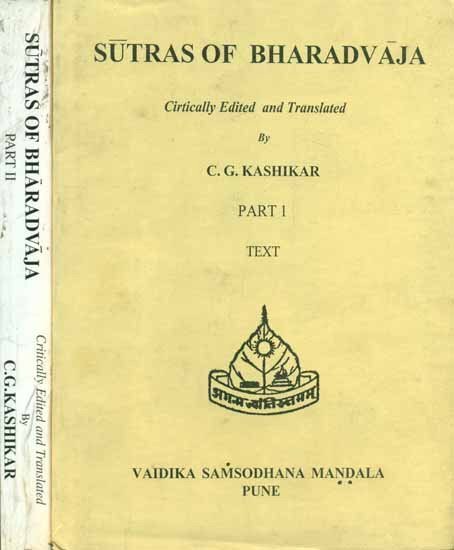Bharadvaja-srauta-sutra
by C. G. Kashikar | 1964 | 166,530 words
The English translation of the Bharadvaja-Srauta-Sutra, representing some of the oldest texts on Hindu rituals and rites of passages, dating to at least the 1st millennium BCE. The term Srautasutra refers to a class of Sanskrit Sutra literature dealing with ceremonies based on the Brahmana divisions of the Veda (Sruti). They include Vedic rituals r...
Praśna 1, Kaṇḍikā 11
1. Then (the Adhvaryu) should give out the call, “Do you strew round, spread the Barhis round the sacred fires, may the fire, round which Barhis has been spread out, be of use to the sacrificer in this world and guaranteeing wishes in the yonder world”.[1]
2. Then he should strew darbha-blades with their ends pointing towards the east, round the fires—those in front and those in the rear.[2]
3. Or the darbha-blades strewn towards the west and the east should have their ends pointing towards the north.
4. The southern spread (of the darbha-blades) should be above (the eastern and the western spread); the northern one below.
5-6. Towards the south of the Āhavanīya fire, (the Adhvaryu) should arrange the seats for the Brahman and the sacrificer. The front one for the Brahman and the rear one for the sacrificer.
7. The sacrificer should himself offer the Agnihotra on the Parvan-day.
8. Even his sons cannot afford to drink milk[3] in the night of the new-moon day.
9. After having offered the gruel as the Agnihotra on that night, the Adhvaryu should keep the remnants of the Agnihotra as the curdling agent.
10. He should cleanse the sāṃnāyya-utensils and arrange them in pairs.[4]
11. (He should arrange) towards the north of the Gārhapatya fire the pitcher, the milking pot, the twig-strainer, the fire-stirring stick, tether for the calf, two fastening cords, and the other necessary materials.[5]
12. After having poured water into the Agnihotra-ladle through the strainers, he should purify it three times by means of the strainers[6] with their ends pointing towards the north, with the (three) pādas of the Gāyatrī verse, “May god Savitṛ purify thee with the fissureless strainers and with the rays of bright sun.”[7]
13. He should recite over the (water) the formula, “You divine waters, that go in front and purify first, lead this sacrifice forward and place the lord of sacrifice in front. Indra chose you for the contest with Vṛtra; you chose Indra for the contest with Vṛtra. You are sprinkled.”[8]
14. He should turn the sāṃnāyya-utensils upwards, and sprinkle them with water by means of the hand with the palm turned upwards.
Footnotes and references:
[1]:
The three, namely, the Āhavanīya, the Sabhya, and the Āvasathya fires.
[2]:
The two, namely, the Gārhapatya and the Dakṣiṇa.
[3]:
Because the entire quantity is assigned to the sacrifice.
[4]:
Āpastamba-śrauta-sūtra I.11.4 prescribes that he should spread out sacrificial grass and arrange the utensils upon it upside down.
[5]:
Āpastamba-śrauta-sūtra 1.11.5 adds an iron or wooden lid.
[6]:
According to Āpastamba-śrauta-sūtra 1.11.6-7 the strainers should be made of two darbha-blades, which are the same size, one span in length, and whose ends are unbroken. They should be cut with the formula, “You are the two strainers...” (Taittirīya-brāhmaṇa III.7.4.11) by means of an instrument, not by means of nail, holding a blade of grass or a stick between the darbha-blades and the instrument.
[7]:
Taittirīya-saṃhitā I.1.5.1.
[8]:
Taittirīya-saṃhitā I.1.5.1.
